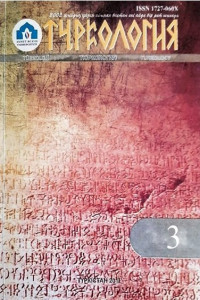Öz
Getting into the historical depth of the lexical composition of any language the amount of the words decreases, but the polysemy increases. The mentioned striking examples are the archetyps *yar- / *kar- , the homogeneous stems and derivatives of which and their phono-semantic variants are widespread in languages of different system of Euroasia. For example, Azerb. уаr- ,Uyg. йар-, Uzb. жар- Kaz. дар- Alt. чар- Chuv. çор- Khak. сур- “cut up, dissect, split, chop, hew, hack, dig”, Azerb. cır- “tear, tear in pieces”, çərt- “incise”, Chuv. çарт- “notch, incision, thread”, Alt. чарт- “thread, groove, lot, plot”, Tat. чирт- “incision, notch, cutting (into pieces)”, Kaz. цыр- цырт- “biset, divide into two”, Russ. черта “line, stroke”, чертить “draw, design”, чертеж “draft”, царапать “scratch”, Old Czechic crtadlo “tool for cutting”, Lithuanian kertu “dissect”, Lettish certu – also, Old Indian krtiş “knife”, Avesta kərəntaiti “cut”.
Azerb. qır- “break, fracture”, qaz- “dig”, Chuv. хыр- “scrape”, Mong. хар- also, Russ. кара “punishment”, карать “punish, destroy, annihilate”, Serbo-Church Slavonic кара “quarrel”, Polish kara “quarrel, reproach, punishment”, Old Irl. caire “blame, reproach”, Serbo-Croatian карати “beat, punish”, common Turkic kas- /kes- / kəs- /…- “cut, dissect, split” and e.s., Russ. косить “mow, cut”, кусать “bite, sting”, кусок “piece, bit, morsel”, Czechic, Slovak kus, Lithuanian kandi, Lettish kuost, Eng. cut, Swed. kota and e.s. – also.
Anahtar Kelimeler
languages of different systems Azerbaijani language verb stem yar-
Kaynakça
- 1. Этимологический словарь тюркских языков. Общетюркские и межтюркские основы на буквы «Ж,», «Ж», «Й». М., «Наука», 1989.
- 2. Федотов М.Р. Этимологический словарь чувашского языка, II т. Чебоксары, Чувашский институт гуманитарных наук, 1996.
- 3. Древнетюркский словарь. Л., Изд-во «Наука» (Ленингкадское отделение), 1969.
- 4. Aharon Dolgopolsky. Nostratic Dictionary. University of Cambridge, UK, 2008.
- 5. Фасмер М. Этимологический словарь русского языка, IV т. М., «Прогресс», 1987.
- 6. Этимологический словарь тюркских языков. Общетюркские и межтюркские основы на буквы «К», «К,». Выпуск второй. М., «Языки русской культуры», 1997.
- 7. Этимологический словарь тюркских языков. Общетюркские и межтюркские основы на буквы «К» (-«Г») и «К,(-«К»-«К»). Выпуск первый. М., «Языки русской культуры», 1997.
- 8. Кажибеков Е.З. Глагольно-именная корреляция гомогенных корней в тюркских языках (явление синкретизма). Алма-Ата, Изд-во «Наука» Каз. ССР, 1986.
- 9. Севортян Э.В. Аффиксы глаголообразования в азербайджанском языке. М., «Наука», 1966.
- 10. Иллич-Свытич В.М. Соответствия смычных в ностратических языках.-Этимология 1966. М., «Наука», 1968, стр. 304-355.
- 11. Кононов А. Н. Семантика цветообозначений в тюркских языках.-Тюркологический сборник 1975. М., 1978.
- 12. Фасмер М. Этимологический словарь русского языка, II т. М., «Прогресс», 1986.
- 13. Dr. Ernest Klein. A Comprehensive Etymological Dictionary of the English language. Volume I. Elsevier Publishing Company, Amsterdam, London, New York, 1966.
Öz
В статье сравнивается и анализируется на примерах появление корневых корней типа яр, кар//кар в тюркских языках, не родственных, а звукозначительно соответствующих вариантов в разных системных языках.
Anahtar Kelimeler
разносистемные языки азербайджанский язык глагольная основа йар-
Kaynakça
- 1. Этимологический словарь тюркских языков. Общетюркские и межтюркские основы на буквы «Ж,», «Ж», «Й». М., «Наука», 1989.
- 2. Федотов М.Р. Этимологический словарь чувашского языка, II т. Чебоксары, Чувашский институт гуманитарных наук, 1996.
- 3. Древнетюркский словарь. Л., Изд-во «Наука» (Ленингкадское отделение), 1969.
- 4. Aharon Dolgopolsky. Nostratic Dictionary. University of Cambridge, UK, 2008.
- 5. Фасмер М. Этимологический словарь русского языка, IV т. М., «Прогресс», 1987.
- 6. Этимологический словарь тюркских языков. Общетюркские и межтюркские основы на буквы «К», «К,». Выпуск второй. М., «Языки русской культуры», 1997.
- 7. Этимологический словарь тюркских языков. Общетюркские и межтюркские основы на буквы «К» (-«Г») и «К,(-«К»-«К»). Выпуск первый. М., «Языки русской культуры», 1997.
- 8. Кажибеков Е.З. Глагольно-именная корреляция гомогенных корней в тюркских языках (явление синкретизма). Алма-Ата, Изд-во «Наука» Каз. ССР, 1986.
- 9. Севортян Э.В. Аффиксы глаголообразования в азербайджанском языке. М., «Наука», 1966.
- 10. Иллич-Свытич В.М. Соответствия смычных в ностратических языках.-Этимология 1966. М., «Наука», 1968, стр. 304-355.
- 11. Кононов А. Н. Семантика цветообозначений в тюркских языках.-Тюркологический сборник 1975. М., 1978.
- 12. Фасмер М. Этимологический словарь русского языка, II т. М., «Прогресс», 1986.
- 13. Dr. Ernest Klein. A Comprehensive Etymological Dictionary of the English language. Volume I. Elsevier Publishing Company, Amsterdam, London, New York, 1966.
Öz
Kaynakça
- 1. Этимологический словарь тюркских языков. Общетюркские и межтюркские основы на буквы «Ж,», «Ж», «Й». М., «Наука», 1989.
- 2. Федотов М.Р. Этимологический словарь чувашского языка, II т. Чебоксары, Чувашский институт гуманитарных наук, 1996.
- 3. Древнетюркский словарь. Л., Изд-во «Наука» (Ленингкадское отделение), 1969.
- 4. Aharon Dolgopolsky. Nostratic Dictionary. University of Cambridge, UK, 2008.
- 5. Фасмер М. Этимологический словарь русского языка, IV т. М., «Прогресс», 1987.
- 6. Этимологический словарь тюркских языков. Общетюркские и межтюркские основы на буквы «К», «К,». Выпуск второй. М., «Языки русской культуры», 1997.
- 7. Этимологический словарь тюркских языков. Общетюркские и межтюркские основы на буквы «К» (-«Г») и «К,(-«К»-«К»). Выпуск первый. М., «Языки русской культуры», 1997.
- 8. Кажибеков Е.З. Глагольно-именная корреляция гомогенных корней в тюркских языках (явление синкретизма). Алма-Ата, Изд-во «Наука» Каз. ССР, 1986.
- 9. Севортян Э.В. Аффиксы глаголообразования в азербайджанском языке. М., «Наука», 1966.
- 10. Иллич-Свытич В.М. Соответствия смычных в ностратических языках.-Этимология 1966. М., «Наука», 1968, стр. 304-355.
- 11. Кононов А. Н. Семантика цветообозначений в тюркских языках.-Тюркологический сборник 1975. М., 1978.
- 12. Фасмер М. Этимологический словарь русского языка, II т. М., «Прогресс», 1986.
- 13. Dr. Ernest Klein. A Comprehensive Etymological Dictionary of the English language. Volume I. Elsevier Publishing Company, Amsterdam, London, New York, 1966.
Ayrıntılar
| Birincil Dil | Rusça |
|---|---|
| Konular | Dilbilim |
| Bölüm | Araştırma Makaleleri |
| Yazarlar | |
| Yayımlanma Tarihi | 24 Haziran 2011 |
| Yayımlandığı Sayı | Yıl 2011 Sayı: 53 |


